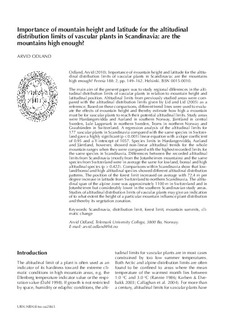| dc.description.abstract | The main aim of the present paper was to study regional differences in the altitudinal distribution limits of vascular plants in relation to mountain height and latitudinal position. Altitudinal limits from previously studied areas were compared with the altitudinal distribution limits given by Lid & Lid (2005) as a reference. Based on these comparisons, different trend lines were used to evaluate the effects of mountain height and thereby estimate how high a mountain must be for vascular plants to reach their potential altitudinal limits. Study areas were Hardangervidda and Aurland southern Norway, Jämtland central Sweden, Lule Lappmark northern Sweden, Troms northern Norway, and Graubünden Switzerland. A regression analysis of the altitudinal limits for 177 vascular plants in Scandinavia compared with the same species in Switzerland gave a highly significant (p < 0.001) linear equation with a slope coefficient of 0.95 and a Y-intercept of 1057. Species limits in Hardangervidda, Aurland and Jämtland, however, showed non-linear altitudinal trends for the whole mountain ranges when they were compared with the highest recorded limits for the same species in Scandinavia. Differences between the recorded altitudinal limits from Scandinavia and the same species from Switzerland were in average the same for lowland, boreal and high altitudinal species (p > 0.422). Comparisons within Scandinavia show that lowland/boreal and high altitudinal species showed different altitudinal distribution patterns. The position of the forest limit increased on average with 72.4 m per degree increase in latitude from Switzerland to N Scandinavia. The altitudinal span of the alpine zone was approximately 1100 m in Switzerland and in Jotunheimen but considerably lower in the south Scandinavian study areas. Studies of altitudinal distribution limits of vascular plants may give an indication of to what extent the height of a particular mountain influence plant distribution and thereby its vegetation zonation. | |

